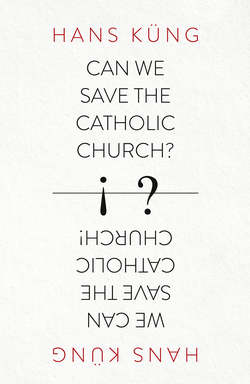Читать книгу Can We Save the Catholic Church? - Hans Kung - Страница 29
The Other Church
ОглавлениеThese are images that have little to do with the triumphal demonstrations of power in St Peter’s Square, but instead reflect what can be experienced thousands of times over around the world. Everywhere I go, I meet deeply committed people in parishes and hospitals, schools and charitable institutions, who in their practical day-to-day involvement in church life are following in the footsteps and in the spirit of the man from Nazareth. They are people who – notwithstanding their personal foibles – do much good for their neighbours and for the community, both within and beyond the boundaries of the Catholic Church. When I look at these people, it becomes impossible for me to think only of the sexual abuse cases and their cover-up or of the other scandals that have recently come to light. All over the world, I have met clergy working on the front line, wearing themselves out in the service of others. I see innumerable men and women who offer support to young and old, to poor and sick people, to those who have been given a raw deal in life, to those who suffer under their own failures.
This is not an idealistic vision of the Church or a mere Utopian projection, but an empirical fact that is confirmed by many other Catholics and Christians generally, and that explains why they, too, do not wish to leave or do away with the Church. And this is the Church with which I can still identify: the global community of committed believers, a community that extends beyond the narrow boundaries of individual denominations. This community of faith is the true Church. Of course, I do not exclude popes, cardinals, bishops or all manner of prelates from this Church, nor do I exclude the dignitaries of other churches either. But, for me, all of these officeholders, who represent the Church as a concrete visible institution, are of secondary importance, since, according to the New Testament, they should only be the servants and not the masters: ‘not that we lord it over your faith, but we work with you for your joy’ (cf. 2 Corinthians 1:24). After all, it was not without reason that, in its constitution on the Church, the Second Vatican Council deliberately placed Chapter II on the ‘People of God’ in front of Chapter III on the hierarchical structure of the Church, although it could not prevent the Curia from scandalously tampering with the text of that chapter. This priority set by the Council should not merely apply in theory but also in practice. In the current reality of the Catholic Church, unfortunately, this is seldom the case.
For the time being, we must wait and see if Pope Francis will prove to be a pope in the tradition of Pope John XXIII, who better fitted St Gregory the Great’s description of the papal office as ‘Servant of the Servants of God’ than the concept behind the customary titles of more recent origin, ‘Holy Father’ and ‘Your Holiness’, that set the pope above his episcopal confreres and give him a quasi-divine status. At the moment, Pope Francis is giving mixed signals. Although he has introduced a new, more simple and humble style into the Vatican, there are also indications that he will take the same hard line on dogmatic, moral and disciplinary issues that his immediate predecessors have taken. And, in the same vein, there are currently relatively few bishops who convincingly demonstrate that they are independent servants of their dioceses rather than compliant servants of the Roman Curia. In any case, I speak for myself and many others of like mind in saying that we are not Christians because of the church hierarchy and we are not Catholics because of the pope in Rome.
I give thanks to another and higher authority (and to many helpful fellow men and women) that my belief has remained unshaken: not my belief in the Church as an institution, but my belief in Jesus Christ, in his person and cause, which remain as the original core of the good traditions of the Church, of its liturgy and theology, and which, despite all of the undeniable decadence and corruption in the Church, have never disappeared and never will. The name of Jesus Christ is like a golden thread in the often torn and besmirched (and, therefore, constantly cleaned and rewoven) fabric of the Church in the course of its history.
And, therefore, at the end of this first chapter I will return to my initial question: ‘Can we save the Catholic Church?’ Yes we can, but only if the spirit of Jesus Christ moves our whole community of faith anew and endows the leadership of the Church with new credibility, understanding and acceptance. That, in turn, depends on those of us who together constitute this community of believers and who are open to the breath of the Holy Spirit, which moves where and as it wills.
Much of what prevents people from being open to the Spirit will be described in the next chapters. I will show how the church community is suffering under the Roman system of power. This system developed gradually, beginning in the first century AD, and was being claimed, theoretically at least, in Rome by the middle of the first millennium. Outside of Rome, however, it found little acceptance until around the end of the first millennium and the first centuries of the second millennium, and then only in the West – with fatal consequences for all of Christianity. It is necessary to soberly and precisely analyse this Roman system to discover whether the Catholic Church could not, perhaps, be saved if it ceased to be enslaved to this system.
